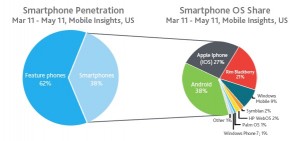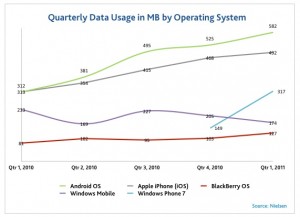As always, Nielsen is providing us with the data that we love. Just check out the smartphone purchase infographic below.
“Smartphones continue to grow in popularity. According to Nielsen’s May survey of mobile consumers in the U.S., 38 percent now own smartphones. And 55 percent of those who purchased a new handset in the past three months reported buying a smartphone instead of a feature phone, up from 34 percent just a year ago.”
 Android smartphones have driven the largest wedge of growth in the US market but have dropped off and iPhone is now the front running. However, Android continues to be the most popular smartphone operating system, with 38% of smartphone consumers owning Android devices.
Android smartphones have driven the largest wedge of growth in the US market but have dropped off and iPhone is now the front running. However, Android continues to be the most popular smartphone operating system, with 38% of smartphone consumers owning Android devices.
I’m not sure why this surprises me, I just thought that because Apple were first to market they would have had the largest market share, especially in the US, but I guess not. Heidi Allen says that in 2010 43% of Australians own a smartphone but Telstra tells us that in October 2010, 36% of Australians with mobile phones, own a smart phone. Telstra also has some interesting statistics about smartphone usage on the toilet and in bed, read the Nielsen research here, done for Telstra.
Smartphone data usage on a steep rise
Inline with increased smartphone mobile ownership, we are also seeing a large rise in mobile data usage. Nielsen says that in the last 12 months (May 2010-May 2011) mobile data usage has increased by 89%. Nielsen claim this rise is due to the almost 50% drop in the cost of mobile data as well as the higher number of mobile apps available, especially the rise in Android and Windows 7 enabled apps.
Android smartphone owners are heavier data users than iPhone owners. Nielsen says that consumers with Android smartphones consume the most data: 582 MBs per month as opposed to 492 MBs for the average iPhone user. Either way, this is still fairly small consumption considering that most mobile phone plans in Australia offer at least 1GB of data – there is still 50% more to use! My own data usage is very modest, under 100MB a month while my phone plan guarantees 3GB. I use my iPhone for data mostly while I’m on the bus to and from work, although I have been known to take my iPhone to bed with me, like 50% of other smartphone users, as Telstra’s research above has highlighted.
With the exception of Windows 7 phones, which have only been available a short time at the writing of this article, there has been a steady incline in data usage (as the graph below confirms). But the real question is, what does this mean for mobile phone network carriers?
In Australia it has been widely reported that the merger between Vodafone and Hutchinson 3 has caused chaos with the network for users – for phone calls and data. I am a Vodafone customer and the service is appalling, I have complained several times and when my contract is up in November, I will be leaving the network. But am I about to find the same data and reception problems on other networks as smartphone ownership and data usage increases and the networks haven’t been able to resource up to support the demand?

